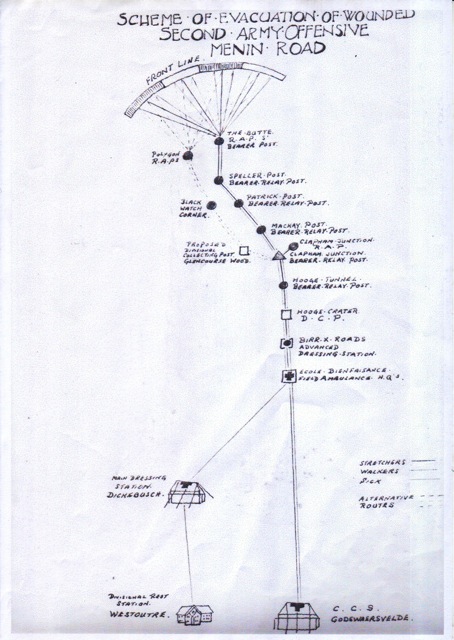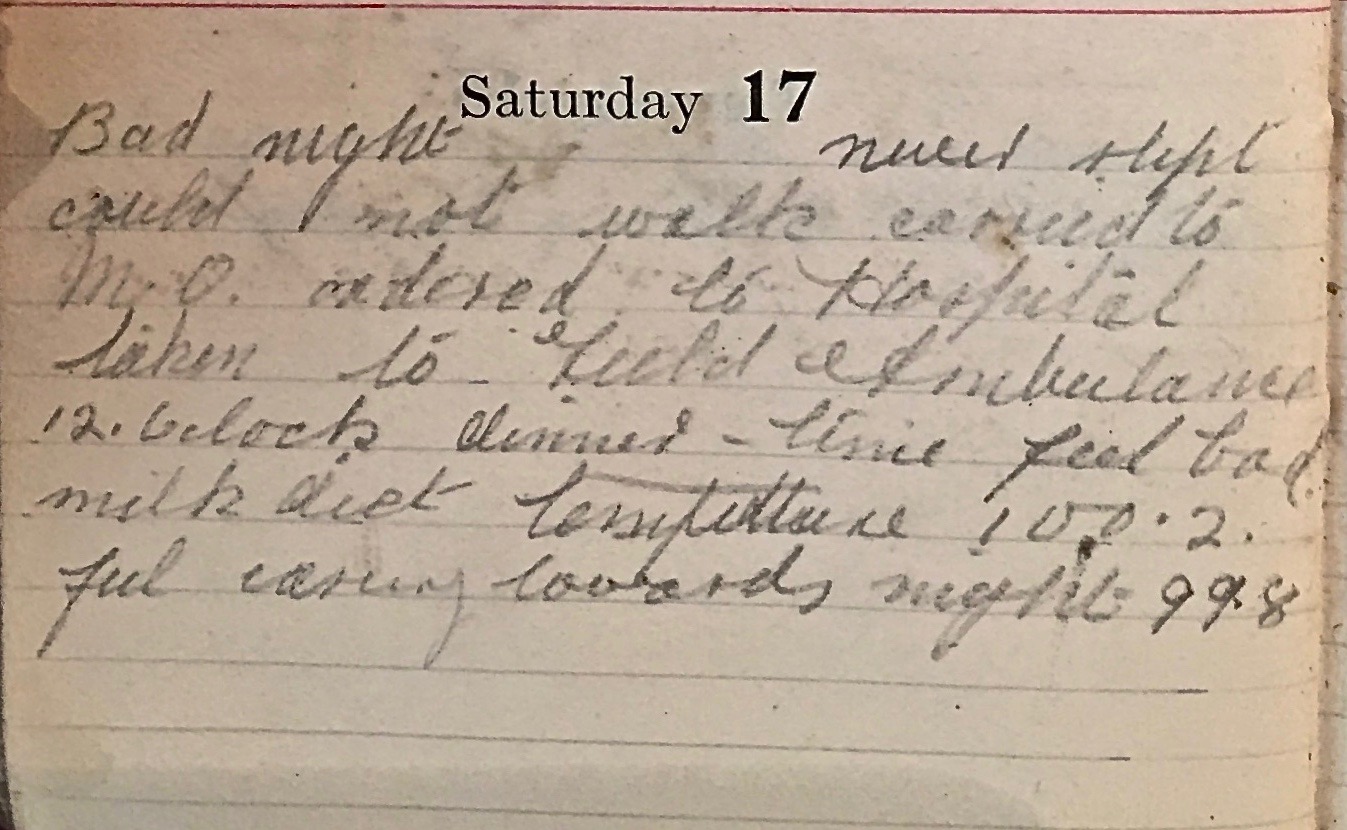Saturday August 17th, 1918
Bad night – never slept. Could not walk – carried to MO and ordered to hospital. Taken to Field Ambulance. 12 o’clock dinner time feel bad. Milk diet, temperature 100.2. Feel it easing towards night – 99.8
Field Ambulance
A Field Ambulance (FA) was a mobile medical unit, one of three usually attached to a Division. Each FA would be assigned to a Brigade and be led by a Lt-Colonel. It was part of a complex chain of evacuation and medical support from the front line. As can be seen in the illustration, there would be Regimental Aid Posts close to the fighting, a crocodile of Bearer Relay Posts towards Collection Posts, then through to Dressing Stations , Casualty Clearing Stations and hospitals further afield.
Scheme of Evacuation

Every soldier was issued with a First Field Dressing that could be administered on the battlefield – by himself, a comrade or a stretcher bearer.
Each battalion had a Medical Officer. Behind the lines, the MO would be responsible for the health of the Battalion, including cleanliness of the camp, its food and water. When in the front line, the Medical Officer would command the Regimental Aid Post. This would comprise his small, full-time team, supplemented by stretcher bearers.
Every Brigade had a Field Ambulance (FA). This typically comprised nine medical officers, one dental surgeon and a further 220 troops and nurses. About a quarter of these troops, usually Army Service Corps (ASC), would be assigned to transportation.
Typically supporting three battalions, the Field Ambulance could work as three co-ordinated but semi-autonomous sections, A-C. Each section had a tent and a bearer sub-section.
The Field Ambulance was responsible for the Bearer and Relay Posts, Collecting Posts, two Advanced Dressing Stations (ADS) and one Main Dressing Station (MDS). Cases were assessed at the ADS. Urgent cases, very occasionally, were handled immediately. However most would be sent to either the MDS (usually located close to the FA HQ) or the Casualty Clearing Centre.
Behind the MDS was the Divisional Rest Station (DRS). This also came under the FA. Its role was to care for sick and slightly wounded men of the Brigade. A man would usually stay there no more than ten days before being returned to his unit.¹,²
Casualty Clearing Station
These were run independently of the FA. By this stage in the war, the Casualty Clearing Station acted a bit like a modern day Accident & Emergency unit. It comprised about 100 staff, including doctors, nurses, orderlies and priests. It could be supplemented by additional surgical teams when in heavy fighting.
It was at the CCS that patients were triaged. Some were helped and then sent back to the line; others transported to Base Hospitals; and the rest, too ill to move, would be treated at the CCS. There was usually one CCS per Division which could accommodate 200 patients and treat over 1,000 cases. It was the closest to the front that women, working as nurses and aids, would be found.¹
Today Frank, away from the fighting, is sent to the 199th Brigade Field Ambulance for hospitalization and care.
9th Battalion / Manchester Regiment War Diary – 17h August 1918 – Haudricourt
Trainingand work as per programme. 1 OR having rejoined is taken on from 16-8-18. 1 OR struck off effective strength on admission to hospital 8-8-18.
References & Further Reading
¹ RACM: Royal Army Medical Corps, WWI, including the ‘Scheme of Evacuation’ sketch which may be subject to copyright
² History of the Great War Medical Services, General History, Volume 1, Sir William G Macpherson, 1921, HMSO



2 thoughts on “Field Ambulance – August 17th, 1918”
Comments are closed.